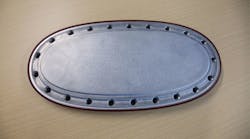Engineers and designers emphasizing “lightweight” materials know that weight is just a number, to borrow a cliché: their real goal is to establish reliable and affordable production processes that will create materials that work in applications where weight reduction enhances performance. “If we can reduce just a few ounces of metal from automobile engine mounting cradles or the housings that hold transmissions we can deliver an impact that is multiplied by the millions,” explained Larry Brown, executive director of LIFT. “In aerospace an added benefit might lower manufacturing costs, as well as increase fuel savings from the lighter weight designs.”
LIFT is the Lightweight Innovations for Tomorrow program, is a “manufacturing innovation institute” operated by the American Lightweight Materials Manufacturing Innovation Institute, a partnership announced last year. It coordinates academic and institutional research with likely and/or available industrial partners, with specific development targets. Within the ALMMI partnership, the U.S. Navy Office of Naval Research administers the LIFT initiative.
The first LIFT project, announced earlier this year aims to develop thin-wall iron castings for automotive transmission cases. It is led by by Grede Holdings LLC and includes Michigan Technological University. Much of the research is being carried out at Grede’s St. Cloud, MN, foundry, and according to Brown it should begin to report its results in “about a year.”
The second LIFT initiative aims to develop vacuum-aided diecasting technologies for aerospace, defense, and automotive applications. It is backed by The Boeing Co., among other manufacturers. Joining Boeing as a lead partner in the research is The Ohio State University College of Engineering, specifically the metalcasting program there.
In standard, high-speed aluminum diecasting, microscopic bubbles of air may form within the molten metal during the mold-filling process. Part designers typically will accommodate the presence of such air voids by specifying thicker dimensions, involving more metal, to achieve the density and strength the finished part requires.
“We know in the laboratory that if we pull all the air out of the mold just before the molten metal flows in, we can eliminate the bubbles,” explained Alan Luo, professor of materials science and engineering and integrated systems engineering at The Ohio State University. “Without bubbles we can design thinner parts that are just as strong and durable, but with less metal and lighter weight.”
Luo, who also is the Foundry Educational Foundation Key Professor, added: “There are other benefits, as well, because the new process allows us to heat-treat parts after they are cast, which will improve their performance in service.”
The OSU metalcasting program is known for its work developing lightweight casting technologies for high-volume manufacturing. Last year, it publicized its development of an integrated diecasting cell capable of manufacturing net-shape magnesium and aluminum castings, the first of its type at a U.S. university. It indicated then that its method for making lightweight cast products for transportation would be available for industrial development and research.
Prof. Luo and Prof. Jerald Brevick, associate professor of integrated systems engineering, along with others at OSU’s Light Metals and Manufacturing Research Laboratory, adapted a Metamag furnace and melt transfer system to a Buhler diecasting machine to conduct their research. “This machine is integrated with — and emblematic of — Ohio State’s manufacturing initiatives,” Luo said in 2014. “This in-house capability is like no other in enabling a considerable number of projects that support the resurgence of manufacturing industry, particularly the casting sector.”
The two-year LIFT project also will address computer modeling of aluminum diecasting performance by combining information about the material microstructure numerous design and production parameters. This integrated computational materials engineering (ICME) process may accelerate design and qualification for new components.
“If you can take a common part, such as an access panel you see on the wing of an airplane, and use high-integrity diecastings, it could reduce weight and manufacturing costs,” commented Boeing associate technical fellow Russ Cochran. “We hope to demonstrate that advances in high-vacuum diecasting will produce parts that meet all the rigorous performance specifications we require, while realizing weight and efficiency goals."
Also contributing to LIFT’s new project will be Alcoa, a primary aluminum producer and aerospace investment caster; Comau, a manufacturer of industrial automation and powertrain systems; Eaton Corp., manufacturers of automotive powertrain systems; and Nemak, a nonferrous automotive foundry group. Institutional partners include Worcester Polytechnic Institute, Southwest Research Institute, the University of Michigan, and Massachusetts Institute for Technology as the research partners.
The American Foundry Society and North American Die Casting Association (NADCA) are involved to disseminate information on how to use the new materials and techniques emerging from the project.
“What we are doing here is bridging that gap between great research in laboratories and great manufacturing skills in private industry,” according to Brown. “Once you bring these innovations into production, the results just multiply.”









